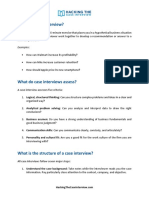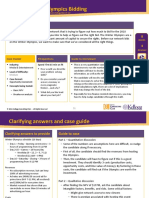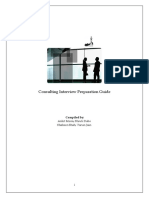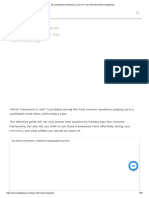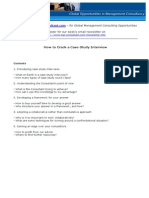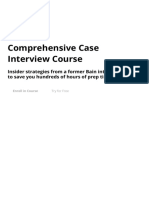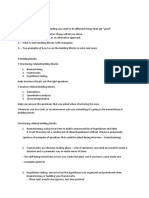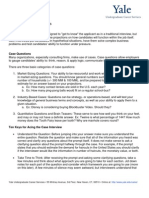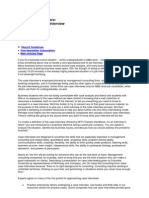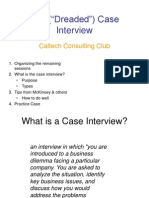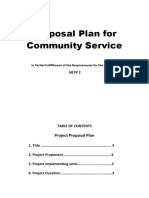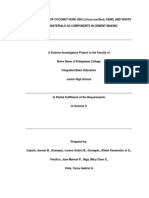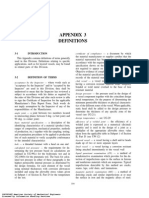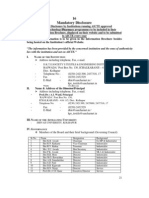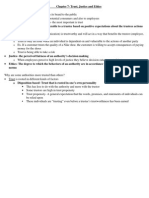Crack The Case System Case Basics
Uploaded by
axstar25Crack The Case System Case Basics
Uploaded by
axstar25Lets Get Started
1
1
C H A P T E R
1
2
t
h
P
a
s
s
P
a
g
e
s
N
o
t
P
r
e
s
s
-
r
e
a
d
y
1
2
t
h
P
a
s
s
P
a
g
e
s
N
o
t
P
r
e
s
s
-
r
e
a
d
y
Get Ready: Cases
Are for Everyone
I
f youre hoping to avoid case interviews, Im going to have to break
it to you: youre out of luck. Case problems are showing up in all
kinds of interview situations, and solving them is now considered a
basic skill for entering many businesses. Companies like giving cases
because they are a great way to test your skills and get a feel for what
its like to work with you. e exact nature of these interviews varies
by company. Some companies give general cases that just test your
logic and thinking, while others get specic by focusing the case on
situations they face or on products and industries that matter to them.
Case interviews are exploding in popularity, and they are not just
designed to torture you. For one thing, putting you in a real busi-
ness situation is simply the best test of your thinking and logic skills.
Ideally, a company would like to hire you for 2 to 3 weeks, work with
you and then have the option to re you if you cant perform. Of
course its doubtful that anyone would want to work for a company
like that. So the case is the best way to replicate a companys typical
daily work, and to nd out if you can solve their kinds of problems.
Giving cases is also useful for measuring how well you deal with ambi-
guity. One of the most challenging parts of an analytical job is coping
with incomplete facts and numbers. Interviewers know that someday
you will face a tough problem, have limited sources and information,
but still have to nd a solution. e best way to predict your perfor-
mance in that kind of situation is to give you a case with limited data.
ats why many interviewers use market sizing cases, or business cases
VI DEO 1 01
What is A Case Interview?
Success is more a
function of consistent
common sense than it
is of genius.
An Wang
3
S E C T I O N
1
2
t
h
P
a
s
s
P
a
g
e
s
N
o
t
P
r
e
s
s
-
r
e
a
d
y
with virtually no information and nothing you can rely on from your
previous experience, because they want to see how you work through
the challenge.
Another reason for giving cases is to pressure-test you. Some com-
panies are intentionally raising the stress level in their interviews.
Variations on the case interview include: multiple candidates in a
room, multiple interviewers, and even creating a presentation within
a tight time-frame. All of these interview styles are designed to test
how youll perform under pressure and to recreate some of the tension
youll feel on the real job. Hiring rms want to know that youll be
able to produce results despite the stress around you.
Its natural to want to focus on a specic interview thats coming up.
You may ask, How does this rm want me to perform? and then
attempt to mold yourself into their culture. But I strongly encour-
age you to rst work through this book systematically, building good
logic, analytical and communication skills that are applicable to many
rms and companies, and then work on focused preparation for cer-
tain rms. (You can learn how to tune up for specic companies and
situations in section 21.) By preparing systematically, youll be ready
to face your near-term challenges and reach your long-term goals.
e skills you build in this process of training for cases will be invalu-
able throughout your career. is 20-minute interview is a miniature
version of how you would attack a real-life problem. Youll be able
to apply the concepts learned here in many situationswhether on
a consulting project or sitting around a table with friends discussing
whether they should start a business. By preparing for case interviews
you are investing in your communication, analytical and advisory
skills. So think not only about your short-term interview goals, but
also consider your long-term career goals, and youll have a stronger
vision for your time commitment.
Fill out the table opposite by listing some of your short-term and long-
term goals. What types of cases are you prepping for specically? Which
of your skills need the most improvement? Do you need to work on your
chart-reading skills, or do you need to revive your math? What commu-
nication and analytical skills do you want to develop for the long term?
VI DEO 1 02
Cases Are for Everyone
Putting you in a real
business situation is
simply the best test
of your thinking and
logic skills.
1
H O M E W O R K
w w w. m b a c a s e . c o m
44
C h a p t e r o n e | S e c t i o n o n e
1
2
t
h
P
a
s
s
P
a
g
e
s
N
o
t
P
r
e
s
s
-
r
e
a
d
y
CRACK THE CASE GOAL SHEET
Time
Period
0
3
M
o
n
t
h
s
4
9
M
o
n
t
h
s
9
+
M
o
n
t
h
s
Goal Skills Concerns
5
G e t R e a d y : C a s e s A r e f o r E v e r y o n e
C h a p t e r o n e | S e c t i o n o n e
1
2
t
h
P
a
s
s
P
a
g
e
s
N
o
t
P
r
e
s
s
-
r
e
a
d
y
1
2
t
h
P
a
s
s
P
a
g
e
s
N
o
t
P
r
e
s
s
-
r
e
a
d
y
Meet Your Competitors:
Derek and Bindu
I
want you to be excited about whats ahead of you. You are going
to improve your logic, analytical and communication skills rapidly
as you use Crack the Case System. Ultimately, we want to bring all of
these skills together under pressure to crack the case and get the job!
But consistently doing well in an oral, logic-based, problem-solving
interview will require quite a bit of practice and time. As your skills
progress, well need to keep in mind another critical factor: the com-
petition. Lets face ita lot of people want the job that you want.
To learn a little more about those youll be up against and how you
might compare, Id like to give you a glimpse into the mind of a typi-
cal interviewer talking with two dierent candidates. Both look great
on paper, with comparable backgrounds and experience. ey are
from the same school and have similar GPAs and GMAT scores. And
they both worked hard preparing for their cases. What will dierenti-
ate them as they try to solve this basic protability case? With which
of them do you identify most as you observe their skills? Each person
was interviewed separately, but lets do our best to put them side by
side and see some dierences through the interviewers eyes.
Interview Day
As Im walking down the hall to the interview holding room, my mind
is racing a mile a minute. Were half-way through the day and we still
15
S E C T I O N
1
2
t
h
P
a
s
s
P
a
g
e
s
N
o
t
P
r
e
s
s
-
r
e
a
d
y
havent found the one. Weve been tasked by HR to keep our picks
to two people and under, since we have several good schools to visit.
Youd think with the top-tier brand of this school, wed have found at
least one good person by now! But if we strike out here its not the end
of world. We dont have to take anyone from this place.
I turn the corner and its the same scene as always. Dark suits, nervous
smiles and hopeful eyesunfortunately, they all look the same at this
point. Here we go . . .
Hi, Derek; Im David Ohrvall.
Hi, Bindu; Im David Ohrvall.
Derek Ding
Derek looks like a nice guy: haircut
not too trendy, no facial hair (my
pet peeve), nice suit, sloppy tie
knot, but overall, very client-ready.
He steps forward quickly after I
call his name in the waiting room
where twenty-ve candidates are
sitting, making small talk with the
greeters. Firm handshake, a little
wet. Good eye contact. Nice smile
and a few pleasant comments
about the weather. He seems
excited and a little high-strung. But
I like this guy; were o to a good
start as we walk to the interview
room.
Today were in a fancy hotel suite
as our rm chose not to interview
on campus. I motion for him to take
the seat across the desk from me.
Bindu Bright
My initial encounter with Bindu is
similar to that with Derek. She has
a calm demeanor but a 1,000 watt
smile. I notice some extra bracelets
that she should have left at home
and her hair is a little messy, but
overall she looks client-ready.
She gives direct answers to my
questions and seems to be keeping
up with my peppy pace. Some of
the candidates today have felt a
little sluggishor worse, giddy. But
not Bindu; shes clearly bringing her
A game.
So far, they are on an equal
footing. Unlike some of the others,
I sense she feels very comfortable
talking to me despite our roles. She
doesnt seem nervous; she takes her
seat and looks eager to begin.
INTRODUCTION TO CASE
Minutes 12
12
6
9 3
1 11
2 10
8
7
4
5
w w w. m b a c a s e . c o m
16
C h a p t e r t w o | S e c t i o n f o u r
1
2
t
h
P
a
s
s
P
a
g
e
s
N
o
t
P
r
e
s
s
-
r
e
a
d
y
As you know, were here today to have you do a case. Id like to take a
brief minute to introduce myself and then well get started. After the
case, well have some time to discuss any questions you have about the
rm. Your next interview is with Amy; it will be a case as well.
After a brief review of my background, I begin. I try to make sure that
I start the case in exactly the same way for each candidate: Todays
case is about durable medical equipment distribution. My client is
going through a number of changes, and I would like you to help
with the situation. Here is a description of the problem. Let me know
when you want to start. I show a slide (below) that contains a mix
of bullets, some relevant and some meaningless. At the bottom of the
slide is the bold-type question, How can DuraMed Depot maximize
protability?
DuraMed Depot
DuraMed Depot is a durable medical equipment distributor
Durable medical equipment includes walkers, beds and
wheelchairs
DMDs customers are mainly hospitals, clinics, retirement homes
and schools
DMD has ve dierent locations throughout the US, located
mainly in large metropolitan areas
DMD has been installing a new integrated information system
and is considering expanding their truck line
Several employees have discussed starting a union, but only in
certain regions
Recently DMD has seen protability drop at several distribution
sites
Im interested to see how many of the points the candidates address
in their analysis.
How can DuraMed Depot maximize protability?
M e e t Y o u r C o m p e t i t o r s : D e r e k a n d B i n d u
17
C h a p t e r t w o | S e c t i o n f o u r
1
2
t
h
P
a
s
s
P
a
g
e
s
N
o
t
P
r
e
s
s
-
r
e
a
d
y
Derek pulls the slide closer and says
hed like to take a minute to review
the information. He holds it tightly
and I notice his left hand leaves a
sweat mark on the desk. Thats not
a good sign. Then the red ags start
ying.
Tense Posture: The head drops,
the shoulders round and the eyes
dart across the page with an inten-
sity that could bore holes into the
paper. Its apparent that the slide is
unnerving him.
Erratic Notes: While looking at the
slide, he scrambles for his notepad
and nervously begins to jot down
a few points. His chicken scratch is
sloppy and erratic. I doubt the notes
will help him later. Im trying hard
not to pre-judge, but I have seen
this all many, many times before.
Stressed Face: Derek is not enjoy-
ing himself much; his face is full of
tension. Im sure he knows better
than to get this worked up during
an interview, but his anxiety is get-
ting the better of him. Would he be
this bad in front of clients?
I try to help him out All of the
information I give you will always
be available, so you dont need to
copy down the bullets if you dont
want to.
He mumbles a quick |o|. and
continues reading. He then asks for
a minute to |oc|oe oo| o |oe
.o|
It does not take Bindu long to
distinguish herself from the other
candidates. After glancing at the
slide, she asks. /||| | e o|e |o |oo|
o| ||| ||oo||o |o|e | ||e ||e
.|e.` She scans the data and takes
a few notes.
Relaxed Posture: Bindu seems like
she does this every day. Its clear she
is ready to get down to work but
she is still very relaxed. Im starting
to get a good feeling about her
abilities.
Organized Notes: As she scans the
data, Bindu quickly takes down a
few notes. I notice that she already
jotted down a few questions for
herself. Her writing is neat enough
to read from across the table and
she keeps me in the loop.
Relaxed Face: Bindu is easily look-
ing back and forth between me and
her notes. She is calm and I could
see her doing well in one of our
more stressful client meetings. Im
hoping that she can back this up
with some good smarts.
Bindu takes charge quickly: ||
||oo||o | |e||o| |J |||e |o |o|e o
|o|e o o oJ |o, oo| o oooc|
||o| .e co J|co |oe||e /ee
|ocoeJ o o||. o ||| e |oo|| o|
e.eoe oJ co| J|.e ||o| .||| |eoJ
o |o oe o|o||o
CREATING THE PLAN
Minute 3
12
6
9 3
1 11
2 10
8
7
4
5
Its clear Bindu is
ready to get down
to work, but she is
still very relaxed.
Derek Ding Bindu Bright
w w w. m b a c a s e . c o m
18
C h a p t e r t w o | S e c t i o n f o u r
1
2
t
h
P
a
s
s
P
a
g
e
s
N
o
t
P
r
e
s
s
-
r
e
a
d
y
After about two minutes (a little
long, but acceptable), he lifts his
head and begins to speak.
Weak Plan to Solve the Case
|| ee ||o| |oo/eJ |eo| .o|
|o o||e o|| ^J o|| |
e.eoe |o co| o ,oo |e||
e o |||||e oe ooo| |o. |oo/eJ
o|e oe, | ||| o|e`
Thats it? Im a little shocked at how
limited Dereks plan is. I sense that
Im going to have to do a lot of
digging to better understand how
Derek thinks. He didnt do himself
any favors by not making clear how
hes thinking through the situation.
As with a lot of candidates, I didnt
hear any case-specic language,
like the words medical equipment
or hospital. Theres also no case-
specic logic about why a durable
medical equipment company,
which seems stable with clients like
hospitals and healthcare facilities,
would see a drop in prot.
Im glad Derek wants to have a
discussion, but his initial question
is so elementary and broad, Im not
sure he wont hit me with more
questions soon. Im ready for the
interview equivalent of the game
show 20 (oe||o.
Bindu is ready to go in about one
minute. She is pointing to her paper
and ready to explain her thinking.
Comprehensive Plan
to Solve the Case
|o| |o ||e |o|e |ce
|oo/eJ |eo| .o| |o |oco o
o|| | |o.e |o|J oo| o o|| |ee
/, |oc| | ||o| o.e ||e |oo/eJ
|eo| |o |o| co|o| o| ||e| co|.
|ce || .oo|J e o |||||e oooo| |o
e.eoe |o |o||o| oJ c|||c
|o Jo oco ||e ooJ C| cooe
e.eoe | J|.e , |ce oJ .o|oe.
o | .oo|J |||e |o |J oo| || ||ee |o.e
ee |ce o|| Jo. e|o |o
coe||||o vo|oe Jec||e coo|J
|oe ecooe o |e. |oe co|o
e coo|J e oJe| |o J||ee|
.eJo ^ |o co|. || .||| e ||ee|
| |o ee || , ||eo, |o|J C ||e
|eJ |Je ||e, o, |o.e ee o
|ceoe | o||||||e. e| o .oe|ooe
eee ^ |o .o|o|e co|. |
co|oo ooo| |oo oJ ||e o||e
||e, oe |o ||e |||e .|ee|c|o| oJ
co|c|e
|| || C| .||| ,oo. |J |||e |o |e| ,
|oc| , |oo|| o| co| || |o ,oo
|o.e co| o|e Jo. , |eJ oJ
.o|o|e o.e ||e |o| 2 o||`
CREATING THE PLAN (continued)
Minute 4
12
6
9 3
1 11
2 10
8
7
4
5
As with a lot of
candidates, I didnt
hear any case-
specic language.
Derek Ding Bindu Bright
M e e t Y o u r C o m p e t i t o r s : D e r e k a n d B i n d u
19
C h a p t e r t w o | S e c t i o n f o u r
1
2
t
h
P
a
s
s
P
a
g
e
s
N
o
t
P
r
e
s
s
-
r
e
a
d
y
Derek presented his approach fairly
well; but overall, hes a little jittery. He
seems to be reading formulas in his
head as hes talking. I get the sense
that he prepared for this interview,
but the conversation doesnt feel
natural and Im not sure Im going to
see solid thinking. The friendliness
and comfortable rapport that Derek
established a few minutes ago have
all but evaporated. I decide to give
him a little push to nd out whats
going on in his head.
Interviewer Drills on
a Part of the Plan
Derek, I think youve covered the
most important categories with
your approach. Lets step back.
What are two key prot drivers for
a durable equipment distributor? I
ask. Now hes back in the game.
C|o,. | |||| oe | |o.| ooJ
e|o||o|| .||| eo|e| oo
|oc|oe |o eoe |o. co| oJ ooJ
.o|e|, ^o||e J|.e .oo|J e o|
|o|| |o e|o||o|| .||| ||e
co|oe. |||e |o||o| oJ oe|
coe |oc|||||e |e, coo|J c|oe o
e|o |o ||e e.|ce ||e, o.|Je.
o .e|| o |o J|||o||o oJ |ooe
Okay, I think were getting some-
where. I feel like Im seeing the think-
ing Derek rather than the stressed
one. Maybe hes nally calming
down and is about to show me how
he can think through some analysis
and deeper questions.
Overall Bindu seems to be thinking
deeply about the topic, much like
any of the top performers at my rm.
Im already imagining her in front
of one of my toughest clients. She
seems quick on her feet! But I need
to push on her thinking a little.
Im not quite sure if I buy Bindus
costs are out of control theory, but
her hypothesis and solid structure
give us a good framework for
discussing the problem. She also
mentioned data that she needs.
Interviewer Drills on
Something Said
Before we dig into any specic data,
could you tell me more about the
costs that may have crept up? I ask.
She seems glad I asked. oe. |
||||| ||| o.o, ooo| co|
||o| oe |oJ |o Je|ec|. |||e Je||.e,
c|oe. |oe|. oco||eooJ o||e
|ceoe o cooe| o| (|||e
.|ee|c|o| occeo|e:. oJ. |o||,.
oJ|||o||o ||o| coo|J |o.e cooeJ
oco||eooJ |ceoe ||o| .oo|J
|o.e o|| o o|| oJoc| ||e
Wow! Were on our way. Im
impressed with her clock speed, as
shes processing information very
quickly and thinking specically
about this type of business.
She put a stake in the ground about
where she thinks the value is, and
she appears ready to test it. Lets see
if shes equally good with numbers.
PUSHING ON THE PLAN
Minutes 56
12
6
9 3
1 11
2 10
8
7
4
5
She put a stake in
the ground about
where she thinks
the value is, and
she appears ready
to test it.
Derek Ding Bindu Bright
w w w. m b a c a s e . c o m
20
C h a p t e r t w o | S e c t i o n f o u r
1
2
t
h
P
a
s
s
P
a
g
e
s
N
o
t
P
r
e
s
s
-
r
e
a
d
y
Diving for General Data
Before we get into the data I have,
I want to see where Dereks head
is. Can you give me some reasons
why a distributor might have prob-
lems being protable? I ask.
||. | ooe ||e| co| |oc|oe
||| e |oo ||| C ||e| e.eoe
|o.e JeceoeJ Joe |o o |Jo|,
.|Je Jo | JeoJ |o eJ|co|
eo|e| |o ,oo |o.e o, oe
||oo||o ooo| ||e| e.eoe`
he asks.
Revenue is a ne place to start, but
I have cost data, so I want to start
there.
It will be easier to compare him
to other candidates if we follow a
similar ow.
You can assume revenues have
stayed constant over the past ve
years, I say.
Derek switches gears immediately:
C|o, |o ,oo |o.e o, ||oo||o
ooo| co|` || .oo|J e e| || .e
coo|J ee || o.e ||e
But what about location, Derek? I
think he forgot about the rst hand-
out in front of him.
Missing Several Insights
I give Derek my handout. The vari-
ability in costs by distribution site
practically jumps o the page; Im
hoping Derek will identify those
dierences between locations and
Diving for Specic Data
Im eager for her to analyze the data
I have, but want to see if shell con-
tinue to drive the case. What would
you like to look at rst? I ask.
o .e |o| .||| .o|o|e oJ
|eJ co| , |oco||o o.e ||e |o|
2 o|| o o` Oo| oc| |o ||e
o||o| |oJoo| ,oo o.e e. || o,
||o| o|| | Jo. o| e.eo| |oco
||o || .oo|J o|e ee |o ee ||
||ee oe o, |oe , |oco||o o .e
|oo| o| ||e Jo|o |e, |o.e ||e e.
| ,|e | o||o. o || .oo|J e
o|oo| |o ee |ceoeJ co| e|o|eJ
|o ||e |ec|o|o,
I like how Bindu is working with the
information in front of her, using
her own approach and the initial
handout I gave her.
She basically asked for the data Im
about to give her, so I hand over the
new slide. Ill be able to compare
her with the other candidates after
she reviews this data and does a
few calculations.
Highlighting Key Insights
Here is some data I would like you
to review. What jumps out to you?
She doesnt stay silent for long
before sharing her insights: ||
Jo|o ||Je | o ooJ .o, |o oo|,e
eoc| J|||o||o ce|e .|o|
,o oo| |o e ||e o| | oc| |||
co| .o|o||||, , |oco||o | ee ||ee
oeo ||o| ee |o e J|.| ||e
DIVING FOR DATA2ND SLIDE AND CALCULATIONS
Minutes 712
12
6
9 3
1 11
2 10
8
7
4
5
It will be easier to
compare him to
other candidates if
we follow a similar
ow.
Derek Ding Bindu Bright
M e e t Y o u r C o m p e t i t o r s : D e r e k a n d B i n d u
21
C h a p t e r t w o | S e c t i o n f o u r
1
2
t
h
P
a
s
s
P
a
g
e
s
N
o
t
P
r
e
s
s
-
r
e
a
d
y
then drill down into the causes.
|| ee |||e co| .o, o |o| , e.|ce
ce|e
Good; he got the main insight.
What do you think is causing such
disparities? I ask.
/e||. oe o| ||e e.|ce ce|e
||| e | oe ee|.e oeo.
.|ee ||e |eo| co| oe |||e C
||e, ||| eeJ |o o, ||e| e|o,
ee oe ecooe || |oJe |o |J
ooJ eo|e
These are decent speculations, but
Derek needs to focus on the slide
and the three areas with the most
variability: direct labor, adminis-
tration, and truck maintenance.
Instead of driving the interview for-
ward by analyzing the data in front
of him, he is taking shots in the dark
and hoping hell hit the target.
.o|o||||, J|ec| |oo. oJ|||o
||o. oJ |oc| o||eoce | .oo|J
|||e |o |oo| o| eoc| oe oJ o| ,oo o
|e. oe||o
Bindu then goes on to system-
atically examine each category by
asking about changes in the last
12 months in order to prove or
disprove her original hypothesis.
She doesnt jump around in her
thinking, but instead moves very
intentionally from one section to
the next. I could see her doing well
with a complicated work stream for
one of our clients and not going o
on tangents. That is an important
skill with our work, as we need her
to be consistently productive and
to meet tight deadlines.
DIVING FOR DATA2ND SLIDE AND CALCULATIONS (continued)
100%
80%
60%
40%
20%
0%
Atlanta Chicago Los Angeles New York Seattle
Total Monthly Expenses by Location
Admin
Maintenance
Truck Leases
Building
Leases
Direct Labor
She doesnt jump
around in her
thinking, but
instead moves very
intentionally from
one section to the
next.
Derek Ding Bindu Bright
w w w. m b a c a s e . c o m
22
C h a p t e r t w o | S e c t i o n f o u r
1
2
t
h
P
a
s
s
P
a
g
e
s
N
o
t
P
r
e
s
s
-
r
e
a
d
y
DIVING FOR DATA2ND SLIDE AND CALCULATIONS (continued)
Slow Math and Limited Insights
Now its time to really nd out who
can hold it together under pressure.
Im expecting Derek to shine here
with his engineering experience. I
know his math training would have
been rigorous and I see he spent
three years in a German school
system, so Im even more hopeful. I
need to move fast as he has burned
up some extra time with longer
pauses than most candidates.
I start in quickly: Your insights on
the data were helpful. Management
wants to analyze the Direct Labor
area. Could you do a few calcula-
tions for me?
Derek grabs another sheet of paper
and seems ready.
I make sure I give him the num-
bers without pause. Total revenue
for the company is about $780M,
with total expenses representing
65%. Within total expenses, Direct
Labor is about 35%. If they have an
opportunity to reduce Direct Labor
expenses by about $25M per year, is
that signicant?
Derek shifts into complete HDDM
modeHead Down Doing Math.
After a few seconds he asks, oo|J
,oo eeo| ||e ||ec| |oo oe`
I wonder if hes stalling, because I
was pretty clear with the numbers.
He seems a little ustered. I think
hes starting to get psyched out. For
about a minute I get a nice view of
Quick Estimates, Accurate
Analysis and Insights
So far, Bindu has proven that she is
a step ahead of the other candi-
dates by thinking specically about
the data she needs. But Im still not
certain that she has the analytical
prowess to handle our work. Her
marketing research background
should have built some solid quant
skills, but you never know until a
candidate does the math.
I attempt to say the same thing Ive
said with every candidate today:
Management wants to explore
opportunities in Direct Labor. I need
you to do a few calculations.
Bindu is already poised with a clean
sheet and ready to go.
I spit out the numbers like I have
done all day. Afterward she inter-
jects, |o ,oo |J || | Jo oe o|c|
e||o|e oJ ||e ||| e |oJ |o e
oe occoo|e || ||o| |e||o|` I tell
her that its ne. Im a little tired
of watching people struggle with
basic math and am wondering if
anyone will get to second level
insights today.
Rather than go completely silent
during her math, Bindu pulls me
into her thinking. o || .e ooJ .S0
|o S00. .ee |oo|| o| 60/ .||c| |
4S0 |o 5/ .||c| | 40. o ooo| 520
30/ .oo|J e 56 oJ oJJ | ooo| S
|o ||e 5/ oJ ||e |o|o| | 64 o |
||e oe o| 65 |o .0
Derek Ding Bindu Bright
M e e t Y o u r C o m p e t i t o r s : D e r e k a n d B i n d u
23
C h a p t e r t w o | S e c t i o n f o u r
1
2
t
h
P
a
s
s
P
a
g
e
s
N
o
t
P
r
e
s
s
-
r
e
a
d
y
DIVING FOR DATA2ND SLIDE AND CALCULATIONS (continued)
the top of his head until he nally
blurts out, /e||. | |||| ||ec| |oo
.oo|J e ooo| 200/ o ||e| o.
| .oo|J e eo|e ||o 0/
Derek is close enough, but awkward
silence follows as its clear that
he has no idea where to take the
conversation. I prompt him to think
about what would constitute signif-
icance for a company when choos-
ing to pursue cost savings projects.
He mentions the size of the savings
and the di culty of achieving them,
but misses timing and the balance
of the savings across locations. Hes
not thinking about making each
service center stronger, which will
be an important part of rolling out
some changes.
Unfortunately were out of time
and we cant solve the break-even
calculation. I debate whether or
not to give it to him, but I dont
think it will sway my opinion of his
analytics, and I dont think its worth
the added stress. I push Derek for a
conclusion despite his incomplete
data set. Im hoping hell recognize
a few gaps and at least put those in
his next steps.
I know hes giving it his best, but
the pressure seems to have aected
his ability to think deeply about the
situation. I feel that he has per-
formed fairly well on the dierent
tasks I posed, like Do this math, or
Tell me your thoughts, but he lacks
the ability to solve the whole prob-
OK, so Bindu can do math in her
head. She would be great to have
along when splitting the dinner bill
among ve friends, but what will
she do with this data?
`oo o|eJ || o.| 25/ .oo|J
e |||co| /||| ||ee oe |
.oo|J o, ||o| ||e, .oo|J e eJoc
| |o|o| ||ec| |oo , 5/. .||c|
ee |o e |o |.e |oo co|
|.e ee | o||e |Jo||e |o| || ||e,
|o.e |o c|ooe .|ee |o o| ||e|
ee, ||e,|| eeJ |o co|Je e.eo|
|oc|o. |||e ||ee|o||o J|| co||,.
o.| oco |oco||o. oJ ||e
o|e||o| |o oo| oJJ|||oo| o.
| o,ec|
I sense shes onto something. How
would you compare multiple proj-
ects? I ask.
|o| eo|e.e co|co|o||o o||e
|c|oJ| o,ec|ec||c |eJ co|
coo|J e oe .o, o| |ce ||ee
oe co| eJoc||o o,ec| ||ee o,
o| e oc| o| o ||||o| |.e|e|
With that comment I give Bindu
my nal data question. Shes only
the second person to get this far
in the case today and her e cient
work earlier in the case is giving her
another chance to shine. With ease,
she calculates two break-evens and
does a solid compare-and-contrast.
She nds that the cost reduction
project in the Admin area is going
to be easier to implement and pro-
vide a better foundation for addi-
tional savings projects. Pursuing
I feel that he has
performed fairly
well on the dierent
tasks I posed, like
Do this math,
or Tell me your
thoughts, but he
lacks the ability
to solve the whole
problem on his
own.
Derek Ding Bindu Bright
w w w. m b a c a s e . c o m
24
C h a p t e r t w o | S e c t i o n f o u r
1
2
t
h
P
a
s
s
P
a
g
e
s
N
o
t
P
r
e
s
s
-
r
e
a
d
y
FINAL RECOMMENDATION
lem on his own. He hasnt owned
the case issue and acted like this
was his company and his problem.
He is at best an average analyst, and
I want someone who will quickly
grow into manager material. I think
he needs a little more experience
and seasoning before hed be ready
for my rm.
Weak, Vague Conclusion
Well, Derek, weve talked about
several things. Whats your nal
recommendation?
Derek slides his papers around and
tries to compose a summary. O|.e
||o| |oo/eJ |eo| | |oo|| |o
|ceoe o||o||||,. | .oo|J eco
eJ ||o| ||e, |oco o ||e ||ec|
|oo |oe |e, co o.e ooo|
25/. o o.e 0/ o| coe| co|
|e, |oo|J o|o co|Je |oo||
o| ^J| co| o ||e, |o. oe
.o|o||||, oco e|o. |o.e.e.
.e J|J| |o.e ||e |o e|oe ||o|
| Je|o|| || .oo|J e ooJ |o |oo|
o| ||o| oo ||o||,. e.e ||oo|
e.eoe |o.e ee co|o| o.e
||e |o| |.e ,eo. ||e, |oo|J o|o
co|Je |oo|| |o e. oo|o
|||e |o o.|| /||| ||e o|
oo|o||o. ||ee |oo|J e e.eo|
e. oeo ||e, co e|e
Im pleased that Derek pulled
together a brief and fairly data-
oriented conclusion; but honestly,
much of it sounded like something
Direct Labor still makes sense and
requires no investment up front,
but the potential employee unrest,
union issues and risk of declining
service make it the second choice.
Practical, Data-Driven
Conclusion
OK, Bindu; lets wrap it up.
oe. she starts in without much
hesitation. o |ceoe o||o||||,
|oo/eJ |eo| |o e.eo| o||o
|e| || |o||, |oo|J e oo
| ||e ^J| o,ec| |.e ||oo|
||e o,oc| e|oJ | |||||, |oe
||o ||e ||ec| |oo o||o. || o|e
o|o| ||e oe o.|. 23/ o
ooo| 45/ o| |o|o| co|
/e o|o |eoeJ ||o| , e|||o||
oe o| ||e |e| c|e| oJ o.e|o
| ocee. ||e ^J| o,ec| e|
||e |oe |o eo.e |.o eJoJo| |
,|e e| ,eo. .||c| coo|J o.e
oo||e 5/
^ ecoJ |o||, .oo|J e |o ||e
e| |oeJ ||ec| |oo eJoc||o
| ^||o|o oJ |e. `o|. oo o|
oo|o|||e ce|e |ee |oco||o
|o.e |oJ oe.e ||| oc||ce oJ
.oe o|e ||o| |oo|J e |oJoJ
|eJ o| |o.oJ
||o||,. .e |ooc|eJ |e|, o| ||e eJ
Minutes 1315
12
6
9 3
1 11
2 10
8
7
4
5
Derek Ding Bindu Bright
M e e t Y o u r C o m p e t i t o r s : D e r e k a n d B i n d u
25
C h a p t e r t w o | S e c t i o n f o u r
1
2
t
h
P
a
s
s
P
a
g
e
s
N
o
t
P
r
e
s
s
-
r
e
a
d
y
INTERVIEWERS DECISION
he could have said before the case
began. Yes, the population is aging,
but its not a topic we mentioned,
so bringing it in at the end wasnt
wise. As for not having time to
explore the Admin area, that was
Dereks fault. A successful candi-
date has to use the data from the
case and Derek just didnt go deep
enough to nd the right insights.
Derek was denitely doing his best
throughout the case, but by minute
ten I knew he was a ding. Overall, I
would rate him as very inconsistent.
Hes obviously an intelligent person,
but he just didnt consistently show
the structured thinking, tenacity,
analytical rigor and ability to see
the big picture that I need in my
employees.
When I knew that Derek was no
longer in the running to get passed
to the next round, my job was to
make sure he had a good time.
I want to give him a favorable
impression of my rm. After all, hes
getting his MBA from one of the top
programs, and in the future he may
be a buyer of our services.
In fact, I think that Derek may have
walked away thinking he did well.
After all, he got through the data,
did some fairly accurate math and
gave a rm recommendation at the
end. But it just wasnt at the level
o| oo J|co|o o ||e o|e||o|
|o |oc| | o e. co|oe. o c|o|
o| oe| coe |oc|||||e || ||e, oe
occe|o|. ||o| o, oo| e.eoe ,
2/ o.e ||e e| |.o ,eo
Home run! Bindu successfully wove
together all the data we had dis-
cussed and did it in a very practical
way. She was solid throughout and
denitely cracked my case.
I am impressed with Bindu. She is
truly bright, a quick thinker who
is willing to challenge her own
assumptions. When she recognizes
a weak spot in her thinking, she
points it out and makes adjust-
ments.
Throughout the case she was con-
sistently logical and stayed focused
on the data. I liked how she worked
her way through each section of
the second handout and explained
the potential drivers of the issue.
She also relied on her business
sense where appropriate. I could
tell that some of the additional
comments she pulled in at the end
were not u and that she is truly
interested in business.
Also, it seems that she is enjoying
the challenge of solving the prob-
lem. She stayed upbeat throughout,
and even when she hit a bump
in the break-even calculation, she
stayed calm and worked it out. I
It seems that
she is enjoying
the challenge
of solving the
problem.
Derek Ding Bindu Bright
w w w. m b a c a s e . c o m
26
C h a p t e r t w o | S e c t i o n f o u r
1
2
t
h
P
a
s
s
P
a
g
e
s
N
o
t
P
r
e
s
s
-
r
e
a
d
y
INTERVIEWERS DECISION (continued)
necessary to move ahead.
Since we can pass only two of our
fourteen candidates to the nal
round, Im condent in my decision
to ding Derek. When I compare
notes with my interview partner
at the end of the day, it turns out
that Derek did a little better on
his second case. I had him ranked
7th out of 12 candidates, and my
interview partner had him in 5th
place. Usually we only have deeper
discussions about the top three to
four, so he is clearly out of the race.
He needed to crack both cases to
make it to the next round. Since he
did worse on my case, I have to do
the ding call tonight. Ill do my best
to give him some feedback, but
theres only so much coaching I can
give in a ve-minute call. I have a lot
of other people to ding as well.
think shed be game to solve any
case I could throw her way and
would have interest in a lot of dier-
ent business problems.
My interview partner ranks Bindu
second out of fourteen candidates
and I rank her rst. Basically, thats
an even match and we both agree
that she is a nal round candidate.
We pass her along with condence.
He was a little concerned about her
leadership experience and we both
agged a few math hiccups. Well
note these issues for the next set of
interviewers. To get a full-time oer
shell need to exhibit brilliance at
cracking cases in three more inter-
views with partners from the rm.
I hope she makes it, but you never
can tell. Her chances are about
50/50 in the nal round. Good luck,
Bindu!
VI DEO 4 02
Types of Competitors
Take a highlighter and mark sections of the Derek and Bindu inter-
views that match traits you have shown in the past when doing
analysis or solving a problem. Do you sometimes fumble with math?
Are you quick on your feet or good at connecting dierent pieces of
information? How do you perform under pressure? Its important to
start recognizing patterns in your previous performance as you pre-
pare to improve your skills.
4
H O M E W O R K
Derek Ding Bindu Bright
M e e t Y o u r C o m p e t i t o r s : D e r e k a n d B i n d u
27
C h a p t e r t w o | S e c t i o n f o u r
1
2
t
h
P
a
s
s
P
a
g
e
s
N
o
t
P
r
e
s
s
-
r
e
a
d
y
1
2
t
h
P
a
s
s
P
a
g
e
s
N
o
t
P
r
e
s
s
-
r
e
a
d
y
Review the Typical Case
Interview Timeline
I
n the last section you got a close-up view of two candidates taking
on an average case. You also probably know by now that you must
crack your case in each and every interview to get an oer. But you
may have noticed with Derek and Bindu that the interviewer rarely
waits until the end of the case to determine how you are doing. In
fact, every step of the case interview holds tests that highlight the dif-
ferences between candidates and ultimately determine who wins out.
Here is an account of every event along the interview timeline, along
with some tips on how to come out on top.
CHECKING IN
Interviews can take place in the school interview rooms or o-site
hotels. Sometimes rms need to go o campus because of timing,
space restrictions or exibility. It also gives them more control than
using the career center and provides a more elegant atmosphere. ey
Pre-Interview Greeting Getting
Settled
Pre-Case
Discussion
Business
Case
Your
Questions
Farewell
Address
1015 minutes
29
S E C T I O N
1
2
t
h
P
a
s
s
P
a
g
e
s
N
o
t
P
r
e
s
s
-
r
e
a
d
y
typically will rent out a oor of deluxe rooms and set up a waiting
room in a large suite. eyll stock it with assorted breakfast or snack
foods (that no one has the stomach to eat) and station a pack of rst-
year associates to make small talk with the candidates. e rms are
highly concerned with brand association, so booking rooms at the
Ritz-Carlton or the Four Seasons adds to their image. If your inter-
view does not take place in a hotel, youll encounter a similar check-in
process at your schools career planning and placement center.
After you arrive and sign in, you should ditch everything but your
notebook and pen. You may nd an array of tempting foodstus, but
it is best to have eaten carefully beforehand. Avoid eating anything
right before the interview; you dont want to be caught with a mouth
full of mu n when they call your name. And food and drink can do
funny things to your voice when youre nervous. Plan what youll eat
on interview day and manage it outside of the interview process (e.g.,
take your favorite protein bar in your bag). You may have to interview
with 34 people in one day so managing your energy is important.
Be sure to turn your attention quickly to the greeters. ey are prob-
ably bored out of their minds and wouldnt mind a little small talk (see
guidelines on page 34). Your job with them is simply to make a good
impression. If you spot someone youve met at a reception or dinner,
then by all means focus on building that relationship. ese people
will not ultimately decide whether you move on, but they can create a
favorable buzz about you. is could help you laterif you make it to
the nal roundas the recruiting sta and partners often talk about
the candidates they liked best.
THE HANDSHAKE AND GREETING
Finally, someone calls your name and you stand to greet him or her
with a handshake. is is your rst point of contact with your inter-
viewer and, therefore, an important event.
These people will not
ultimately decide
whether you move on,
but they can create a
favorable buzz about
you.
Pre-Interview Greeting Getting
Settled
Pre-Case
Discussion
Business
Case
Your
Questions
Farewell
Address
02 minutes
w w w. m b a c a s e . c o m
30
C h a p t e r t w o | S e c t i o n f i v e
1
2
t
h
P
a
s
s
P
a
g
e
s
N
o
t
P
r
e
s
s
-
r
e
a
d
y
A handshake is very personal. You are taking the palm of a strangers
hand and pressing it against your owna weird custom, when you
think about it. Although some germaphobes would like to see the
handshake disappear, it is not going anywhere soon. e best hand-
shake is dry, rm and very brief. Wet or moist ones are the worst.
Lengthy handshakes are too personal. No exceptions.
Any deviation from dry, rm and brief will leave a negative impres-
sion. Here are a few folks that no interviewer wants to encounter.
Limp Linda or Lifeless Luke
Her grip couldnt pull a parachute cord to save her life. You know who
Im talking about: the woman apparently afraid to shake hands. She
puts it out there like a gentle ower, and as soon as you grab hold you
realize its already wilted. Youre afraid that you may have hurt her. Or
there is the guy who feels like he has a doughnut for a handyou cant
help but think hes weak. If you have a soft handshake and you dont
have time to hit the weights, at least give it your all when you shake
hands. Lean into it if necessary.
Sweaty Sam or Sticky Sally
Hi, nice to meet you, Sam. Im David. Hands meet and we stick
together for what seems like an eternity. Your hand feels like a wet
sponge. Yuck! Finally we separate, and Im looking for a sink or a wet
wipe. I used to know a consultant who cleaned his hands with a gel
sanitizer after every handshakein front of the candidates! He told
them it was to ward o the common cold, but Ill bet he was really just
trying to remove the feel of Sweaty Sams and Sticky Sallys. ere is no
more disgusting way to start an interview.
Weve all had the sweaty-hands problem. Getting nervous and sweat-
ing is inevitable. Honestly, if youre a big-time sweater and theres
nothing you can do about it, then heres a simple solution: in the
waiting room press your palm to the couch or your pant leg to keep it
dry. For the rest of us, a quick (and subtle) wipe of your hand on your
pants or jacket should do the trick.
Any deviation from
dry, rm and brief
will leave a negative
impression. Here are
a few folks that no
interviewer wants to
encounter.
T y p i c a l C a s e I n t e r v i e w T i m e l i n e
31
C h a p t e r t w o | S e c t i o n f i v e
1
2
t
h
P
a
s
s
P
a
g
e
s
N
o
t
P
r
e
s
s
-
r
e
a
d
y
Bone-Crusher Bob or Bruiser Barb
Hello, Bob, Im David. I reach for the hand and then: crunch.
Woware my bones still intact? Bone-Crusher Bobs out there, take
it easy. ere is a huge dierence between rmly squeezing a hand
and pulverizing a hand. Be especially careful if youre shaking a female
partners hand: a little goes a long way. If you nd that the handshake
coming back at you is a little weaker than expected, back o quickly.
Disabling the interviewer is not a good start to your discussion.
How do you perfect your handshake? As with everything else, prac-
tice. Find an understanding friend and keep testing your handshake
until you get it right. Along with your warm smile, it is perhaps the
strongest part of your rst impression, and it matters more than you
might think.
YOUR CLOTHING
Some of my strangest moments as a candidate involved interviewers
scanning my appearance from top to bottom, without an ounce of
subtlety. Wed meet and say hello, and then their eyes would travel
from my hair down to my shoes and back up again. It felt bizarre to
be so overtly checked out. But it happened for good reason: the inter-
viewer just wanted to know whether I t the part.
Appearance and rst impressions are important in the business world,
as clientswhether internal or externalexpect you to be professional
and produce results. Lets hope your interviewers wont be so brazen
when checking your appearance, but expect it to happen occasionally.
You didnt buy this book for fashion advice, so I wont attempt to
adjust your closet. But if you want to get hired, you must remember
one simple rule: dont wear or carry anything that distracts attention
from you and what you have to say. Here is my Avoid-At-All-Costs
list. Believe it or not, I have seen each of these mistakesmore than
once.
There is a huge
dierence between
rmly squeezing a
hand and pulverizing
a hand.
w w w. m b a c a s e . c o m
32
C h a p t e r t w o | S e c t i o n f i v e
1
2
t
h
P
a
s
s
P
a
g
e
s
N
o
t
P
r
e
s
s
-
r
e
a
d
y
THE WALK TO THE ROOM
You have avoided the food but are holding a small juice to calm your
nerves. A minute or two before your o cial interview time, you set
it down, dry your hand and wait. After hearing your name called you
step forward, oer a huge smile, make solid eye contact, say hello,
shake hands and then proceed to the interview room. In some cases,
my room was a good fteen to twenty hotel doors away from the wait-
ing room. Some interviewers will do their best to immediately begin
engaging you with small talk on the way; others will walk quickly,
saying little, solely focused on getting you into the room and starting
the case. is is your rst glimpse of the interviewers communication
style. Is he pleasant and friendly? Is she quiet and a little brusque? Its a
good bet that what you see here will be similar to what you experience
when you start the case.
Men
Avoid the following
Cologne (just skip it; your interviewer might
be allergic)
Loud ties (no cute symbols or characters)
Jewelry or rings of any type, except a
wedding band
Facial hair (some rms are more accepting
than others, but why not nd out after youre
hired?)
Weird pens or notebooks (keep it simple; no
one is impressed by a Mont Blanc)
Any suit color other than black, blue or gray
Any shirt color other than white or French
blue (why risk it?)
Really bold pinstripes in your suit
Unkempt or unprofessional hair (one partner
I knew nicknamed a candidate the Beatles
haircut kid)
Women
Avoid the following
Perfume (just skip it; your interviewer might
be allergic)
Too much jewelry (less is more)
Over-styled, crazy hair
Weird pens or notebooks (keep it simple; no
one is impressed by a Mont Blanc)
Loud scarves or suits (what would you wear
to a manufacturing client in a conservative
town?)
Overly decorated shoes
Purses or bags (store them in the waiting
room)
Red or long fake ngernails
Bright lipstick or too much make-up
T y p i c a l C a s e I n t e r v i e w T i m e l i n e
33
C h a p t e r t w o | S e c t i o n f i v e
1
2
t
h
P
a
s
s
P
a
g
e
s
N
o
t
P
r
e
s
s
-
r
e
a
d
y
SMALL TALK
A little chatter here and there is natural with any interview. Try to stay
relaxed, but keep in mind that you are being evaluated at all times. It
is amazing what pops out of the mouths of nervous candidates! If you
tend to say silly things in such situations, try to say as little as possible.
To give yourself a head start and to calm your nerves, below are some
suggested topics. Your tone should always be positive. Do not com-
plain about anything, or you may appear to be high-maintenance, a
denite turn-o among co-workers.
Pre-Interview Greeting Getting
Settled
Pre-Case
Discussion
Business
Case
Your
Questions
Farewell
Address
34 minutes
Bounds
The weather (The town is beautiful when
covered with two feet of snow . . .)
Your commute to the interview (No problem,
tra c was light today . . .)
The interviewers city (I got a chance to
spend the weekend there . . . it was great!)
Your school, including your classes (It has
been better than I expected . . .)
Interview week (Ive had a chance to meet a
lot of interesting people . . .)
Out of Bounds
Your or your interviewers appearance
Your or your interviewers family
Your health
The details of other rms activities (top-notch
rms do not talk about their competitors)
Your lack of experience with cases
Your desire to work only in one city (wait until
asked, then be careful)
Where you are headed after the interview (be
vague; its none of his or her business)
Your grades or GMAT scores (they probably
have them, so wait until asked directly)
w w w. m b a c a s e . c o m
34
C h a p t e r t w o | S e c t i o n f i v e
1
2
t
h
P
a
s
s
P
a
g
e
s
N
o
t
P
r
e
s
s
-
r
e
a
d
y
Getting Settled in the Room
If you are interviewing in a hotel room, you might be a little unsettled
to see a bed about seven feet from the interview desk. Try not to feel
uncomfortable. Many interviewers keep the door ajar with the metal
safety latch. e room should be perfectly neat since the hotels oer
early maid service. As an interviewer, I always had to be up and out
of the room by 7:00 .. to ensure ample clean-up time. You may see
an open suitcase or a pile of dirty clothes in the corner. Try to ignore
them.
Typically, the room will contain a desk or table. e interviewer will
point to where you should sit. If you are solving a case, position your-
self to write on the table. is means youll need to assume what I
call the attentive pose, sitting on the front half of the chair, leaning
slightly forward, ready to respond to whatever comes your way. Try to
get comfortable, since you will probably be in that position for most
of the interview. If you move around too much youll seem dgety
and nervous. Your interviewer may move around quite a bit. You,
however, are expected to stay in good form, so do not relax, even if the
interviewer does.
Pre-Interview Greeting Getting
Settled
Pre-Case
Discussion
Business
Case
Your
Questions
Farewell
Address
56 minutes
PRECASE DISCUSSION
WHAT THEY REALLY WANT TO KNOW
Do I Like You?
If there is a pre-case discussion about your background, it happens
right now. is part of the interview can go in several dierent direc-
tions. e interviewers main purpose is to get a feel for your personal-
ity. Some people like to call it the Airport Test or the Pizza Test, as in
If I got stuck at the airport with you, or had to work late and share
a pizza with you, would I want you on my team? If you think this
is incredibly subjective and judgmental, youre right. e interviewer
T y p i c a l C a s e I n t e r v i e w T i m e l i n e
35
C h a p t e r t w o | S e c t i o n f i v e
1
2
t
h
P
a
s
s
P
a
g
e
s
N
o
t
P
r
e
s
s
-
r
e
a
d
y
is determining whether you would t into the rms social circle. Do
your best to be engaging with the following mental checklist:
Am I making eye contact?
Am I listening well?
Do I appear pleased to be here and interested in what is being
said?
Am I smiling consistently (not like a crazed clown, but
pleasantly)?
Am I matching conversational pace (in sync with the
interviewer)?
Why do you want to work for us?
Some people like to jump right into the case, since they know it will
take about 20 minutes and they dont want to run out of time. Others
start the discussion with a few questions about you and your career
aspirations. Here are the basics:
Are you interested only in my industry?
is is a very tricky question. If you say yes, it shows you are focused.
But it also shows that you are probably lying. Most people have a
backup plan in another industry. If you say no it might indicate that
you are not focused.
Answer with condence along these lines: My primary focus is con-
sulting / marketing / high tech, but Im interested in a few other areas
as well. No one can fault you for having a variety of interests.
Why consulting? Why banking?
Why this industry (e.g., consumer goods)?
e best answers are direct and tight, as in I love to solve problems,
learn about lots of dierent businesses and face tough challenges on a
regular basis. Consulting seems like a good t. If you are interested
in marketing, launching new products might be where you want to
put your energy. Or if banking or nance attracts you, emphasize the
w w w. m b a c a s e . c o m
36
C h a p t e r t w o | S e c t i o n f i v e
1
2
t
h
P
a
s
s
P
a
g
e
s
N
o
t
P
r
e
s
s
-
r
e
a
d
y
quant and deal nature of the work. ink carefully about why you
really like something: your responses will ring true and youll be able
to answer with condence.
Be prepared with a couple of crisp bullets for each of the categories
you are pursuing.
What other firms are you pursuing?
You will hear this question infrequently during your rst round of
interviewing, but in the later rounds it is usually asked. Dont lie, but
keep it vague at rst. You want to assure them that they are not your
only opportunity and that you are pursuing their competitors. Dont
tell a McKinsey interviewer that you are also interested in a small bou-
tique IT shop, for example; he might question your t.
Who Are You?
Some interviewers may use this warm-up time to learn whether youre
sharp and on the ball. ey might ask you to talk about your resum.
Short, focused answers are better than long ones. Keep your answers
to the point, and let the interviewer ask you a follow-up question if
he wants to know more. is discussion may take one of the follow-
ing paths:
Coolness/Uniqueness Factor
Partners love to nd the next cool superstar. You know that person:
hes bright, attractive, fun and an Olympic gymnast! Or shes smart,
outgoing, friendly, and was a backup singer for Beyonc! One partner
I know prided himself on nabbing the top student of each pro-
gram. Some interviewers love athletes. Others notice musicians. All
of these campus celebrities still have to crack the case like everyone
else. If they do, the interviewers and recruiting sta have more to talk
(and gossip) about back at the o ce. But these candidates also have
a slight disadvantage, as their extra uniqueness can sometimes lead to
conversations that burn up precious time that should be spent on the
case. If you dont consider yourself to be exceptional, take a fresh look
at your resum. ink about your graduate school essays. Remind
yourself how amazing you really are.
T y p i c a l C a s e I n t e r v i e w T i m e l i n e
37
C h a p t e r t w o | S e c t i o n f i v e
1
2
t
h
P
a
s
s
P
a
g
e
s
N
o
t
P
r
e
s
s
-
r
e
a
d
y
Quantitative Quickie
is could be anything from a simple math question to something
quantitative on your resum. Look through your resum and think
about the analytical tasks you may have done at dierent points
in your school and work experience. Test yourself to see if you can
describe what the goal was, how you structured the analysis, what you
did and what the nal result was.
Strengths, Weaknesses and Other Basic Questions
Much has been written on how to best respond to these questions.
My main advice is to prepare answers in advance and practice saying
them out loud. Hearing yourself answer will reveal any awkwardness
or di culties. You never know when they will come up and you dont
want to be caught o guard. For more detailed prep on these types of
questions check out Section 7.
Pre-Interview Greeting Getting
Settled
Pre-Case
Discussion
Business
Case
Your
Questions
Farewell
Address
722 minutes
THE BUSINESS CASE QUESTION
e case will usually last about twenty minutes. Most interviewers
want to have time at the end to talk about your conclusion and answer
your questions about the rm.
Although your case can last a full fteen to twenty minutes, it is usu-
ally decided within the rst ve to ten. By that time, the interviewer
knows whether you are in the bottom, middle or top third of the
roster. Even if yours is the rst interview of the day, the interviewer
has likely given this case many times before, so its easy to bucket you.
If you fall into the middle or bottom third, there is no hope. If you are
in the top third, you have a ghting chance.
w w w. m b a c a s e . c o m
38
C h a p t e r t w o | S e c t i o n f i v e
1
2
t
h
P
a
s
s
P
a
g
e
s
N
o
t
P
r
e
s
s
-
r
e
a
d
y
YOUR QUESTIONS ABOUT THE FIRM
You need to do your homework in advance. Your best resources are
the rms website, company literature, company representatives and,
especially, past employees of the rm. Make sure you take the time to
develop questions that will give you additional insight about the rm.
Many students do not prepare in advance and miss this opportunity.
ey are often ustered or mentally wiped out after the case, but a
simple question written in their notebooks ahead of time would keep
them on track. One rule of thumb is to focus on the interviewers
experience. Even if you get dinged, you can at least learn something
from someone who is living the life you want to lead. Here are some
questions to consider and some to avoid.
Pre-Interview Greeting Getting
Settled
Pre-Case
Discussion
Business
Case
Your
Questions
Farewell
Address
2325 minutes
Good Questions
What was your biggest lesson from your rst
year of work?
What skills were most important to your
success during your rst year here (at the rm
or company)?
Do you still nd your work to be challenging?
What part of the lifestyle has been the
biggest surprise?
What types of projects is your o ce focusing
on right now? (strategy vs. operational)
What kind of problem are you trying to solve
for your client/customer presently?
How has your role changed, in terms of
dealing with your clients/customers, over the
last two years?
Not-so-good Questions
(you should already have the answers)
How much training does a rst year
associate/analyst receive?
Do new hires in your o ce travel much?
How long does a typical project last?
What would some of my main responsibilities
be as a rst-year?
Will there be a chance to interact with the
client or customer over the summer?
How has your o ce grown over the last
couple of years?
How many years does it take to make partner
or director?
How did I do on the case?
T y p i c a l C a s e I n t e r v i e w T i m e l i n e
39
C h a p t e r t w o | S e c t i o n f i v e
1
2
t
h
P
a
s
s
P
a
g
e
s
N
o
t
P
r
e
s
s
-
r
e
a
d
y
THE FAREWELL ADDRESS
Well, its overnot just the case, but also the decision about whether
you will go on to the next round (or get an oer). At best, the inter-
viewer has placed you in one of the top three positions in the pile.
Each interviewer completes a score sheet rating each candidates per-
formance. Some try to do it during the interview and ll in the gaps
after the candidate leaves, while others start the process at the end of
the interview. In either case, they usually end the conversation a little
early to nish it. You can expect to be out of the room a few minutes
before the o cial end of your time slot.
Normally the interviewer will bid you adieu at the door of the hotel
room. By now you have asked all of your questions, and the whole
experience is truly over. A warm smile, a brief handshake and a thanks
for your time are all that is required. You will head back to the recep-
tion area and encounter the greeters again. If you get a dopey question
like How did it go? respond with a huge smile and say, Great! If
nothing else, you will further unnerve the candidates-in-waiting.
Lets get started on a piece of output that youll denitely need later: your
key questions for the rms. Think about your top choices of where you
want to work and the type of information you want to understand better.
For starters, you may want to know about training, hours, types of proj-
ects, timelines, length of projects, industries of focus and overall growth
trajectory for the team, group or rm. Jot down these topics and then
think carefully about where youll get this information. If you can research
it on your own, youll now be smarter about the company. What remains
will give you the topics for your questions. Now begin crafting the ques-
tions youll want to ask. These will come in handy during quick chats with
company personnel or throughout the interview process.
Pre-Interview Greeting Getting
Settled
Pre-Case
Discussion
Business
Case
Your
Questions
Farewell
Address
2627 minutes
5
H O M E W O R K
w w w. m b a c a s e . c o m
40
C h a p t e r t w o | S e c t i o n f i v e
1
2
t
h
P
a
s
s
P
a
g
e
s
N
o
t
P
r
e
s
s
-
r
e
a
d
y
MY QUESTIONS FOR THE COMPANY
Sources (Web Site,
Peers, Company Rep)
Company Name Key Topics Questions
T y p i c a l C a s e I n t e r v i e w T i m e l i n e
41
C h a p t e r t w o | S e c t i o n f i v e
1
2
t
h
P
a
s
s
P
a
g
e
s
N
o
t
P
r
e
s
s
-
r
e
a
d
y
Prep According to Case Type
BASIC CASE TYPES
A
s the 2x2 matrix below illustrates, you may face a variety of cases
throughout the interview process. Its important to not only be
aware of all the case types, but also allocate your
preparation time carefully. us, as you read through
this chapter, try to understand your present classi-
cation as a candidate, the position you want, what
cases you would typically be expected to do, and
your present skills.
Referring to the matrix on this page, there are
four basic ways that you may be tested during the
interview:
Resum, Leadership & Persuasion
Business Case
Fit & Personality
Market Sizing & Brainteaser Cases
ese four interview types will vary by interviewer,
rm, interview location and, of course, your experi-
ence and education level. Some of them may overlap. A calm resum
discussion could heat up quickly as your interviewer turns your expe-
rience at Ford Motor Company into a mini business case. Or a market
Resum,
Leadership &
Persuasion
Business Case
Market
Sizing &
Brainteaser Cases
Fit &
Personality
Undergrad
MBA
Lateral Hire
PhD, Grad
43
S E C T I O N
1
2
t
h
P
a
s
s
P
a
g
e
s
N
o
t
P
r
e
s
s
-
r
e
a
d
y
sizing case can easily be embedded into a business case (e.g., estimate
how big the toothbrush market is while discussing the launch of a new
type of toothpaste).
Depending upon the position you are seeking and your current status,
you will receive a dierent set of cases during your interviews. On the
2x2 matrix, one bubble represents the typical set of cases that a more
senior candidate would receive. For MBAs, Lateral Hires, PhDs and
graduate students, the interview will likely include a heavy emphasis
on the business case, a review of your resum and a discussion of your
leadership experience. ey will also seriously assess how your per-
sonality will t with the company culture. Everyone in this group can
expect to encounter tough, business-oriented analytical cases that are.
e second bubble represents undergraduates, or candidates who
have not completed graduate-level work. ey would be entry-level
analysts in the consulting rm, marketing organization or industry
department. Cases for these candidates may involve some business
cases, but they will tend to emphasize math and analytics in a Market
Sizing or Brainteaser format. Additionally, leadership and t will play
a big part in the decision process.
As much as you would like the interview process to be very straightfor-
ward and consistent (like an SAT or GMAT exam), its not and never
will be. So my best recommendation is that you become aware of the
full set of cases you could encounter and then prioritize your prepa-
ration according to your skills and available study time. Your main
objective should be to remove all variability in your interview perfor-
mance. As you become more consistent with each problem format,
you will nd that your condence grows and your excitement about
the interview process will increase. Interviewers are most impressed
with someone who is at ease during the interview and appears to be
enjoying the case analysis and discussion. And of course, when you
relax, your best thinking and personality traits come out. Lets move
through each case type and review what will be expected of you.
RESUME, LEADERSHIP & PERSUASION
What is it?
Just as the title implies, companies want to understand you better by
reviewing your resume and drilling in on your experience as a persua-
w w w. m b a c a s e . c o m
44
C h a p t e r t w o | S e c t i o n s i x
1
2
t
h
P
a
s
s
P
a
g
e
s
N
o
t
P
r
e
s
s
-
r
e
a
d
y
sive leader. A simple resum review could include discussing where
you worked and for how long. You will be expected to explain the type
of work you did and the impact you and your team (or division) had
on the company. You may also have to recount a detailed example of
how you applied your leadership skills to a tough situation.
How should I prepare?
Here is a practical approach that will take the story of your experience
and leadership to a whole new level:
Save your resum as a new electronic document. Name it something
like My Resum Long Version.
For each major section in your resum, write out answers to the
following questions. Dont worry about being too precise at rst.
What did I do during this time of work? What was my main job
and output?
How was I a leader? Give an example of how you persuaded a
person or group to do something. Examples that describe a tough
situation are best.
What did my team (or group) do? What was our main objective
and how did our work inuence the company?
What was going on at the company level while I worked there?
Were there any shifts in the industry or major changes in the
company?
Now that you have taken the time to write out your main ideas, rene
each answer into a tight one- to two-sentence response. Be sure to
bring your main idea to the front part of your statement in order to be
as answer-rst as possible.
Once you have written up your best answers, print out the document
and put it in your briefcase or backpack. When you have free moments
throughout the day, read through the document. Soon these well-
written, concise answers will ow freely anytime youre asked about
your experience. In a sense, youve methodically re-wired your mind to
give the best responses when asked.
Where do candidates typically go wrong?
Most candidates under-prepare for this type of interview. They
You will be expected
to explain the type of
work you did and the
impact you and your
team (or division) had
on the company.
P r e p A c c o r d i n g t o C a s e T y p e
45
C h a p t e r t w o | S e c t i o n s i x
1
2
t
h
P
a
s
s
P
a
g
e
s
N
o
t
P
r
e
s
s
-
r
e
a
d
y
incorrectly assume that because they know their own experience,
theyll give good responses.
Interviewers want to understand how you think. Be ready to give
details when asked. An interviewer might ask, So, what did you say
next? If the conversation happened three years ago, of course you
wont remember exactly. But you need to convey what you think was
said and how you were thinking. The interviewer is trying to predict
how you might act in future situations, so help him with details.
MARKET SIZING & BRAINTEASER CASES
What are they?
ese cases are basically math problems that you have to solve. e chal-
lenge is that typically you are given very little information and few facts
upon which to base your calculations. You will be expected to make
logical assumptions, build some basic facts and then do some calcula-
tions. For market sizing problems, youll need to determine the size of a
market (e.g., the number of people who will buy a new shampoo). For
brainteaser questions, youll have to solve a tough riddle that may even
seem silly (e.g., how many ping pong balls would t in an SUV?). You
will be expected to give an answer at the end of the calculation.
How should I prepare?
Solving quite a few is the key here. You need to solve a signicant
number of market sizing and brainteaser cases to ensure your com-
fort with making assumptions about each situation. For market sizing
problems, be prepared to give assumptions about population size (e.g.,
US population), number of consumers (e.g., dogs that eat dry dog
food) and typical caveats (e.g., some children may be allergic to the
new product). Brainteasers can also be conquered over time once you
master the ability to make good assumptions. Most people who study
for these types of cases become consistently good at solving them.
Weve dedicated half of Section 9 to training you on how to handle
the communication and analytical challenges that market sizing cases
present. Years ago, they were isolated to undergraduate interviews, as
that type of interview tests math skills well. Now they crop up in
the middle of longer cases and as stand-alone cases for MBAs and
graduate students. I believe they are excellent at training you in how
w w w. m b a c a s e . c o m
46
C h a p t e r t w o | S e c t i o n s i x
1
2
t
h
P
a
s
s
P
a
g
e
s
N
o
t
P
r
e
s
s
-
r
e
a
d
y
to speak and how to communicate your assumptions and logic. In the
back of the book we have eight market sizing cases. I would recom-
mend training with those and then looking for an additional ten in
other resources. Undergraduates should spend more time preparing
for these types of problems.
Where do candidates typically go wrong?
I nd that candidates are hesitant to throw stones at their own assump-
tions. Since it is a problem that requires estimating, be prepared to
explain how your analysis may under- or over-estimate the answer.
Also be prepared to explain how you would rene the answer if you
had more time. Check out Section 9 to better understand SPEAK, my
method for solving market sizing cases.
FIT & PERSONALITY
What is it?
ere is no precise test for this category. Instead, members of the com-
pany are trying to understand your background and your personality
and whether or not you t well with their rm. ey will do this
through questioning and observation.
How should I prepare?
As clich as it sounds, be yourself. In the end, if you are not a person-
ality t for your target company, it will be an unhappy situation for
both you and the company. Do your best to understand the typical
personality and culture of each company to which you apply. Keep in
mind that a company is made up of many people, so if you run across
someone you dont like or t with, give them a few more chances.
Where do candidates typically go wrong?
Candidates often do not take the time to learn about each company.
Remember, interviewers are most interested in their own company,
not your aspirations to join an industry. If you prepare ahead of
time, you are more likely to ask good questions and get along well
P r e p A c c o r d i n g t o C a s e T y p e
47
C h a p t e r t w o | S e c t i o n s i x
1
2
t
h
P
a
s
s
P
a
g
e
s
N
o
t
P
r
e
s
s
-
r
e
a
d
y
with the company culture. Learning each companys particular lingo
(e.g., case vs. study vs. project, or deck vs. slide vs. storyboard) can
also help you t a little better.
BUSINESS CASE BASICS
Background
e top companies want to put your brainpower to the test. As a
result, business case questions are becoming more complex and multi-
layered. You should expect to be asked a question that involves an
industry you may know very little about (e.g., hedge funds) or one
that you have never thought much about (e.g., diamond mining).
You should also expect to have to cover several business concepts in
one case: for instance, introducing a new product and discussing the
supply chain changes necessary to support it.
If study time permits, you can pursue expertise at tting ping-pong
balls into football stadiums or counting the number of pigeons in
New York city seven dierent ways, but be sure to fully prepare for the
type of case you will most likely encounter during your interviews: the
business case question.
What is it exactly?
In a case interview you typically receive a business problem to solve.
You are asked to work your way to a solution in about twenty minutes.
ese cases are often drawn from real-life problems that the interview-
ers have helped solve in the course of a client engagement.
Obviously, no one can expect you to solve in twenty minutes a prob-
lem that took a team of people four months to conquer. Because of
this time constraint, the interviewer is often prepared to dole out data
to assist you with your analysis. Sometimes this data is given verbally,
and sometimes it takes the form of charts and graphs (called slides
in the consulting biz). eres one catch: you typically must gure out
what kind of information you need and ask for it. e interviewer will
not necessarily hand it over without you asking rst.
When I was preparing for my case interviews, I often heard that there
is no wrong answer to a case. is is completely false. Several right
answers may exist, buttrust methere is an innite variety of
w w w. m b a c a s e . c o m
48
C h a p t e r t w o | S e c t i o n s i x
1
2
t
h
P
a
s
s
P
a
g
e
s
N
o
t
P
r
e
s
s
-
r
e
a
d
y
wrong answers. While your approach to the case and your agility with
facts and gures can leave a great impression with the interviewer, you
must reach a well-reasoned and supported answer to achieve success.
Is it effective?
Companies seek candidates who can consistently think on their feet,
be logical in their problem-solving approach, and handle unexpected
curve balls with aplomb. A case question does a pretty good job of
giving the interviewers a glimpse of how to rate the candidate on these
skills. Most companies oer positions only to those candidates who
have cracked all of their cases (typically four or ve); this practice
assures the rms that they have found the best available candidates
during a very short and intensive interview process.
Many rms expect their interviewers to have cases prepared in advance
and pre-tested by other members of their team. is method ensures
that the cases are neither too long nor too simple. Nevertheless, its not
uncommon for a partner to show up unprepared and invent a case on
the y. ese spontaneous cases can result in very easy or very di cult
interviews.
TYPES OF BUSINESS CASES
Despite the hundreds of case variations, they tend to fall into a few
broad categories. To keep all the case types straight, I will use ve
categories, or zones; most of your interview cases will fall into the rst
two zones. Well discuss these groupings in greater detail later in the
book. In the meantime, remember that your ultimate goal is to maxi-
mize the value of the company being discussed in your case question.
Keeping this goal in mind will broaden your perspective on your cases
and help you think more like a business advisor. Rather than getting
caught up in the details of only one aspect of the business, you must
take on the perspective of the CEO.
Zone 1Strategic Cases
Many people in the business world disagree on the true denition of
strategy. As you prepare for your cases, you will nd the word strat-
egy slapped on the back of almost any case title (e.g., pricing strategy,
systems strategy and operational strategy). A good working deni-
Several right answers
may exist, but
trust methere is
an innite variety of
wrong answers.
P r e p A c c o r d i n g t o C a s e T y p e
49
C h a p t e r t w o | S e c t i o n s i x
1
2
t
h
P
a
s
s
P
a
g
e
s
N
o
t
P
r
e
s
s
-
r
e
a
d
y
tion of strategy is maximiz-
ing value with a limited set
of resources. With strate-
gic cases, you are making a
change that will have a large
impact on the business as a
whole, not a small adjust-
ment like changing a prod-
ucts price or launching a
new advertising campaign.
Zone 2Operations Cases
Operations cases focus on
the internal operations of the
company. Since we want to
maximize the value of the company at all times, operations cases have
two major drivers: revenue and cost. What emerges are various ways to
impact those drivers. It would be easy to call any of these cases a strategy
case (e.g., pricing strategy),
but I nd that naming them
as such prevents you from
focusing on the key value
levers themselves. Revenue
and cost are the most basic
levers in business, so you
should expect to see a lot of
cases touch on them.
Zone 3Organization,
Systems and Process Cases
We are now entering the
fuzzy zone. e catego-
ries in Zone 3 represent real
potential business issues, but they dont necessarily oer clear-cut
ways to increase overall company value. For instance, a new computer
system may provide more insight into how the business is perform-
ing, but unless it eventually results in more revenue or fewer costs,
it does not maximize company value. Solving these cases involves
donning your CEO hat. Make sure that you do not get stuck in the
minutiae and forget about the larger goal of making money.
ZONE 1 STRATEGIC CASES
Expand Scope
Merge
Acquire
Form a joint venture
Change Direction
Enter/Exit a market (add/eliminate a
product line)
Develop and sell new products/services
Reposition the company (brand/image)
Reduce Scope
Divest a business or
division
Maintain Status Quo
Keep the business
the same
ZONE 2 OPERATIONS CASES
Increase Revenue (Price x Volume):
Increase pricing:
Change pricing by segment
Increase volume
Keep present customers (loyalty)
Acquire new customers
Increase share of wallet with present
customers
Sell more in new places and ways
Reduce Costs:
Assess xed vs. variable
Assess internal vs. external
costs
Benchmark costs to other
companies
Assess operational
minimum costs
w w w. m b a c a s e . c o m
50
C h a p t e r t w o | S e c t i o n s i x
1
2
t
h
P
a
s
s
P
a
g
e
s
N
o
t
P
r
e
s
s
-
r
e
a
d
y
Zone 4Finance Cases
Cases in the nance zone
cover a companys nanc-
ing and balance sheet items.
Strategy cases often touch on
this area, so you should be
prepared to incorporate some
basic nance principles into
your analysis. In Section 12
well go through the SAVED
model for those cases that
dive deep into nance.
Zone 5External Forces
Another term for this zone
might be the Reaction Zone,
as the issues here demand
that the company react in
some manner. For example,
a competitive threat case can
result in an acquisition strat-
egy, a pricing reduction or an
exit from the industry. Zone
5 cases always result in the
company taking some type of
action.
THE MOST LIKELY
SCENARIO
Now that youre panicking over
the laundry list of case types
listed on the previous pages,
lets apply a little 80/20 logic
to focus your eorts. Later in
the book you will see how the
Maximum Value Model pulls
these zones together in a way
that is easy to remember and
apply in your interviews.
ZONE 3 ORGANIZATION, SYSTEMS AND PROCESS CASES
Impact the People:
Change the organizational
structure
Change peoples roles
Change peoples incentives
Change the management
team (or Board of Directors)
Change the Process/Systems:
Change information
technology (broad or
narrow)
Change procurement
Change sales
Change inventory
Change distribution
(including Internet)
Measure the Organizations Capabilities:
Assess skill sets
Assess and streamline
processes
Centralize or decentralize
Assess production
capacities
ZONE 4 FINANCE CASES
Impact the Balance Sheet:
Assess inventory/
receivables
Assess debt/equity mix of
the company
Assess cash management
Buy back shares of the
company
Execute o-balance sheet
nancing
Increase Equity Returns:
Improve capital e ciency
Increase shareholder value
ZONE 5 EXTERNAL FORCES
Respond to supplier issues
Respond to public attitude/
perception changes
Respond to economic changes
Respond to a competitive threat
Respond to an industry shift
Respond to auditor issues &
concerns
Address legislative and
regulatory changes
Respond to technological
changes
P r e p A c c o r d i n g t o C a s e T y p e
51
C h a p t e r t w o | S e c t i o n s i x
1
2
t
h
P
a
s
s
P
a
g
e
s
N
o
t
P
r
e
s
s
-
r
e
a
d
y
Within the business case question category lie a variety of potential
case questions. Keep in mind that the purpose of the interview is
to ascertain whether you can think like a business advisor. In order
to measure your skills and also to make sure they oer a case that
most people can solve in a reasonable time frame, most interviewers
will stick to Strategy Cases (Zone 1) and Operations Cases (Zone 2).
ese areas provide a rich set of issues that will put your abilities to
the test. e beauty of being familiar with the other zones is that if the
interview jumps into those other areas, you wont get lost.
Keep in mind that each case a rm gives provides a glimpse into the
type of work they do. No rm wants to be seen as non-strategic or
focused on mere support issues. erefore, most questions you receive
will be deemed strategic, even if they more properly fall into another
zone.
Zone 1 and Zone 2 Favorites
Within the strategy and operations zones, a few issues appear fre-
quently. ey are, in no particular order, the following:
Maximize prot (Help! My company is losing money.)
Enter a new market
Develop / Launch a new product
Sell more of the same stu to more people (products or services)
Reduce costs
Respond to competitors
Merge two companies
All of these cases work well in a case interview format because their
problems are clear and their answers center on core business concepts.
ese cases are eective in revealing which candidates can frame a
solution and which cant. Also, many of the interviewing companies
actual client problems (the source for most case interview questions)
relate to these issues.
Fill out the short quiz opposite on case types. Knowing the dierent ways
youll need to prepare will be helpful as you manage your practice time.
VI DEO 6 01
Case Interview Types
6
H O M E W O R K
w w w. m b a c a s e . c o m
52
C h a p t e r t w o | S e c t i o n s i x
1
2
t
h
P
a
s
s
P
a
g
e
s
N
o
t
P
r
e
s
s
-
r
e
a
d
y
CASE TYPE QUIZ
Question My Answer What Did I Forget?
What types of cases will I likely
face in Zones 1 and 2?
Where do candidates usually
go wrong with resum,
leadership & persuasion
questions?
What are some basic steps
to solving a market sizing
question?
P r e p A c c o r d i n g t o C a s e T y p e
53
C h a p t e r t w o | S e c t i o n s i x
1
2
t
h
P
a
s
s
P
a
g
e
s
N
o
t
P
r
e
s
s
-
r
e
a
d
y
You might also like
- Interviewing - Case Structured Interviews - 1100% (1)Interviewing - Case Structured Interviews - 15 pages
- Case Interview Cheat Sheet and Study GuideNo ratings yetCase Interview Cheat Sheet and Study Guide7 pages
- 23 MBA Consulting Casebooks With 700+ Free Practice Cases100% (1)23 MBA Consulting Casebooks With 700+ Free Practice Cases7 pages
- Comprehensive Case Interview Prep CourseNo ratings yetComprehensive Case Interview Prep Course10 pages
- The Ultimate Case Interview Cheat Sheet and Study Guide100% (1)The Ultimate Case Interview Cheat Sheet and Study Guide15 pages
- Case - McKinsey 1st Round Case Party Burger100% (1)Case - McKinsey 1st Round Case Party Burger14 pages
- Wharton Consul Ti NG CL Ub: Interview Study GuideNo ratings yetWharton Consul Ti NG CL Ub: Interview Study Guide62 pages
- Case Interview Guide for Caltech StudentsNo ratings yetCase Interview Guide for Caltech Students16 pages
- Case Interview Prep for Business StudentsNo ratings yetCase Interview Prep for Business Students13 pages
- Journal To Get A Sense of How Companies Deal With The Kinds of Issues Likely ToNo ratings yetJournal To Get A Sense of How Companies Deal With The Kinds of Issues Likely To5 pages
- UDCGrad Center Case Interview Guide Final v2No ratings yetUDCGrad Center Case Interview Guide Final v227 pages
- Interview Guide - Casebook Wharton 2003 (1) .NB100% (2)Interview Guide - Casebook Wharton 2003 (1) .NB98 pages
- Gcse Geography Coursework Methodology Table100% (2)Gcse Geography Coursework Methodology Table6 pages
- Saint Gregory Academy: Indang, Cavite S.Y. 2017 - 2018100% (1)Saint Gregory Academy: Indang, Cavite S.Y. 2017 - 20182 pages
- THE FEASIBILITY OF COCONUT HUSK ASH (Cocos Nucifera), SAND, AND WASTE PAPER MATERIALS AS COMPONENTS IN CEMENT-MAKING100% (1)THE FEASIBILITY OF COCONUT HUSK ASH (Cocos Nucifera), SAND, AND WASTE PAPER MATERIALS AS COMPONENTS IN CEMENT-MAKING6 pages
- (Ebook PDF) Clinical Kinesiology and Anatomy 6th Edition PDF Download100% (3)(Ebook PDF) Clinical Kinesiology and Anatomy 6th Edition PDF Download86 pages
- Liquid Retaining Structures: Crack-Width & Reinforcement Review100% (1)Liquid Retaining Structures: Crack-Width & Reinforcement Review12 pages
- Analisis Akuntabilitas Politik Reses, Studi Tentang Kegiatan Reses Anggota DPRD Provinsi Jawa TengahNo ratings yetAnalisis Akuntabilitas Politik Reses, Studi Tentang Kegiatan Reses Anggota DPRD Provinsi Jawa Tengah16 pages
- Continuous Assessment School Placement 1 Reflective Essay: Gmit Examinations - 2016/17No ratings yetContinuous Assessment School Placement 1 Reflective Essay: Gmit Examinations - 2016/174 pages
- Finite Element Methods in Mechanical DesignNo ratings yetFinite Element Methods in Mechanical Design11 pages
- Sto. Tomas Senior High School: Department of EducationNo ratings yetSto. Tomas Senior High School: Department of Education69 pages
- Chapter 5 - Discrete Random Variables and Their Probability DistrubutionsNo ratings yetChapter 5 - Discrete Random Variables and Their Probability Distrubutions9 pages
- PERT-CPM-WBS (ES 12 Engineering Management)100% (1)PERT-CPM-WBS (ES 12 Engineering Management)70 pages
- 999 016 - Ditto Motion To Dismiss With Memo (00354120)No ratings yet999 016 - Ditto Motion To Dismiss With Memo (00354120)27 pages
- Knowing More Than One Language: The Psycholinguistics of BilingualismNo ratings yetKnowing More Than One Language: The Psycholinguistics of Bilingualism47 pages






